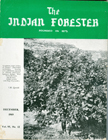"Mysore-Gum" in India
DOI:
https://doi.org/10.36808/if/1969/v95i12/26205Abstract
Recent studies of timber trend and prospects in India have revealed a widening gap in the supply and demand of wood in the country. To meet this shortage, various short term and long term measures have been taken up in the country. One of the major steps in the direction of achieving this self-sufficiency in wood is in the form of raising of plantations of fast growing tree species. Under these schemes, plantation of various species have been tried in different parts of India. The success achieved in case of many species varies from good to indifferent depending upon the locality and other factors but one species which has shown promise in the early stages in a very wide range of climatic and edaphic conditions, right from sea-coast to the Himalayas, is Eucalyptus of Mysore origin, which has been recent1y shown to be mostly Eucalyptus tereticornis (Pryor, 1966 and Qureshi, 1966). As the identity of the species has not yet been fully established, the author will still prefer to call it by its popular name "Mysore-Gum". The present paper gives a review of the plantations of "Mysore-Gum" in some parts of India, based on the observations made on tours undertaken with the classes of the Indian Forest College. It primarily deals with the techniques of raising plantations and analyzes its future possibilities as a 'fast-growing' species in different parts of India.Downloads
Download data is not yet available.
Downloads
Published
1969-12-01
How to Cite
Kaushik, R. C., & Singh, B. (1969). "Mysore-Gum" in India. Indian Forester, 95(12), 931–938. https://doi.org/10.36808/if/1969/v95i12/26205
Issue
Section
Articles
License
Unless otherwise stated, copyright or similar rights in all materials presented on the site, including graphical images, are owned by Indian Forester.





